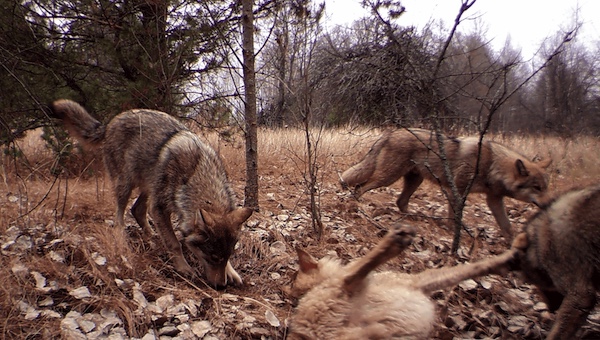
NUCLEAR WOLVES - UGA
RADIOACTIVE CHERNOBYL IS A WILDLIFE HAVEN AFTER 38 YEARS OF NUCLEAR DISASTER
BY: MARIA MOCERINOORIGINAL SITE: INTERESTING ENGINEERING
The landscape today is brimming with wildlife, something which ecologists didn’t expect.
The explosion at the Chernobyl Nuclear Power Plant 38 years ago today marked a terrible tragedy in human history. The toxic clouds that spread over Soviet territory exposed approximately 8.4 million people to nuclear radiation.
Over 250,000 people developed cancer, and approximately 100,000 cases ended up being fatal.
Beyond the damage incurred by human beings that pervades to this day, the Chernobyl disaster wreaked havoc across the landscape by causing extensive damage to crops, plants, and infrastructure.
The failure to report the accident and its magnitude resulted in crucial delays in response that could have prevented thyroid cancer, specifically, fatalities and other long-term consequences that a nuclear power plant explosion of that degree triggers.
The International Chernobyl Disaster Remembrance Day — what did we learn?
The UN commiserated April 26 as the International Chernobyl Disaster Remembrance Day in 2016 to continue to support the affected communities, honor human life, and reflect on what we’ve learned from the tragedy in looking ahead toward a more sustainable future.
Radioecologists have taken sites that required human evacuation, such as Chernobyl, as unique opportunities to study what happens when humans move out of these landscapes.
“Radiation is pervasive around us at very low levels,” Beasley, a researcher at the University of Georgia, said. “By studying the impacts of exposure and using these landscapes as models, we could better understand the broader implications beyond Japan and Eastern Europe.”
Though the area saw an incredible loss — of humans — it stunned ecologists to find that wildlife took over. The absence of human beings triggered plant life to flourish and animal life to return, so Chernobyl appears more like a nature reserve today. And no one expected it.
Chernobyl became a wildlife reserve, unexpectedly
Radioactive levels may have decreased due to radioactive decay, but the risks to human beings remain permanent. Therefore, ecologists thought that the presence of wildlife would be less abundant if not depressed, but that turned out not to be the case.
“Species like Eurasian lynx and brown bears have naturally colonized the area,” Beasley said.
In an unexpected turn of events, scientists could reintroduce endangered species in Chernobyl, such as the European Bison and Przewalski’s horses native to the steppes of Central Asia.
And though these populations thrive, researchers still don’t understand how radiation affects animals, even in low quantities. Radio-ecologists thus want to gather that data to determine radiation’s impact on wildlife and human life, too, as we absorb radiation daily.
New technology to measure external radiation exposure
Researchers at the University of Georgia developed a collar to help them study radiation in zones that are uninhabitable and dangerous for humans to enter. Furthermore, scientists cannot just displace wildlife especially when exposed to radiation.
However, they can study these cases to deepen our knowledge. In a moving twist, life perseveres even in the most contaminated areas.
They attached the collars to wolves to track their movements, which, as a technology, captures data quickly and sends it to a scientist’s computer via satellite.
They can measure external exposure, at least, as there are two ways to absorb radiation: by consuming contaminated substances such as food or water or passing radioactive plants or soil.
They’ve deployed this collar, allowing them to investigate external radiation‘s effects on wildlife and human life.
They’ve deployed this collar around the world which allows them to investigate the effects of external radiation on wildlife and human life.
Nothing can alleviate the masses that the Chernobyl Disaster impacted. Wildlife, however, seems to endure, if not flourish, after all these years — 38 — which presents a hopeful picture.
We believed it was beyond repair. That’s not the case, at least. Scientists can continue to use the site to develop new tools and carry out meaningful research on radiation.
The goal of this international day of remembrance remains intact and honored: to learn as much as we can.
AWFSM CATEGORIES
Activism | AI | Belief | Big Pharma | Conspiracy | Cult | Culture | Deep State | Economy | Education | Entertainment | Environment | Faith | Global | Government | Health | Hi Tech | Leadership | Politics | Prophecy | Science | Security | Social Climate | Universe | War
